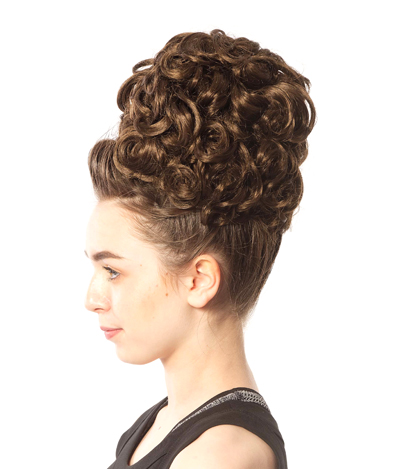
If you are an Irish dancer or the parent of an Irish dancer, you’ve probably had to grapple with the issue of putting a bun-cover wig on a dancer’s head at some point. Bun cover wigs can be pretty important for Irish dancers who have gotten out of the ‘just starting out’ stage, but they can also be a little overwhelming to put on, especially the first time. We briefly tackled the issue of how to put bun covers on in our article on your first wig a few months ago, but today we’ll be taking a deeper step-by-step look into the process to clear up as much confusion as we can.
First and foremost, here is what you will need:
A bun cover wig, like our Kara Single, Keara Single, or Keara Double
2 Heavy-duty hair elastics
A set of jumbo bobby pins
A comb, preferably with a rat tail
A dancer to put all this stuff on
There are a few other items that are optional, but really useful:
A set of wig screws
Regular bobby pins
Now that you’ve got everything, let’s get started!
1. You’ll want to start with slightly dirty hair.
Freshly washed or wet hair is difficult to work with. If your dancer’s hair is silky clean, de-tangle it and then give it a pass over with hair spray to add some texture and make it easier to control. If it’s not fully clean, just use a comb or brush to get any knots or tangles out of it that might cause you problems later.
Now is the time to decide whether you want a pouf or a swoop at the front, or just have her hair pulled straight back. If your dancer is anything other than a Beginner or Advanced Beginner, we recommend that you opt for a pouf or swoop. Take the comb and part her hair just in front of one ear all the way across her head to just in front of the other ear. You can comb it in front of her face, or twist it up and have her hold it to keep it out of the way for the next step. Don’t worry about getting too much hair. It’s much easier to hide a bit of extra hair away than pull out more hair without destabilizing the bun. The more you do this, the more you’ll get an idea of how much hair you need to start with.
2. Using your fingers, pull your dancer’s hair into a high ponytail right on top of their head.
Think of Cinderella’s hairstyle. It helps if they’re looking straight up with their chins towards the ceiling while you do this, otherwise, the ponytail won’t be in the right place. Now comes the only part that might pull her hair a bit. Wrap one of the hair ties around the ponytail, all the way down against her head, as tightly as you can. Here’s an example of a wig in place: note how tightly pulled up the back is.

PRO TIP: If your dancer’s hair tends to slip out of hair elastics, give it a spritz of hair spray to “glue” it in place and add a second hair tie to really lock it down.
3. Twist or braid the ponytail into a bun.
It has to be secure enough that it doesn’t move if you grab hold of it and- GENTLY!- try to wiggle it around. This is the foundation of your wig, so don’t be afraid to redo it if it comes out too loose.
PRO TIP: If you aren’t comfortable making a tight bun, or your dancer’s hair is difficult to neatly wrap into a tight bun, putting it in a braid before turning the braid into a bun can be helpful. It doesn’t have to be pretty, because it won’t be visible. Just make it tight.
Put a second hair tie at the bottom of the braid and secure the bun with jumbo bobby pins, being sure to go under the 1st hair elastic, close to her head, to lock it in place. Make sure you haven’t caught any hair you need for a pouf or bangs! There won’t be much opportunity to free it later. Work your way around the bun, using 4-6 jumbo bobby pins, and secure the bun tightly. It should not move much if you try to wiggle it.
PRO TIP: Tell your dancer to let you know if the bobby pin is poking or hurting her after you get it in, and if it does, move it now. There will not be an opportunity to do so later without fully pulling the wig apart and starting over.
4. Take a hair donut, stretch it so the hole in the middle is wide open, and put that over the bun to give it some more volume.
Pin it in place with jumbo bobby pins, being sure to get the bobby pins under or securely into the hair bun. The donut may not be necessary if your dancer has very long or very thick hair, especially if she has a small bun cover, but for most dancers, this is a necessary step to prevent the bun cover from being a bit loose or floppy. Don’t worry if the back or sides of the head are a bit messy; it can be fixed later. If you need to use multiple donuts, stack another one on top of the first and pin the top donut securely to the base donut.
PRO TIP: check that the bun base is stable at every step. If it’s not, use more bobby pins. If that doesn’t work, you may need to start over.
5. Take the wig cover and put it over the donut.
There’s a string around the opening of the cover, which you can pull to tighten the cover over the donut. Make sure not to pull it too tight, or it can end up looking like a ball sitting on top of the dancer’s head instead of being part of their hair. Ideally, it should be shaped less like a softball sitting on their head and more like a scoop of ice cream. Wrap the cord around the bun cover and secure the ends with a jumbo bobby pin or two.

PRO TIP: If your bun cover is brand new and very flat, pull the string slightly to make a cup shape; getting it over the donut will be easier that way.
Most bun cover wigs have clips and combs built into their rim if you want to use those, but you should also secure the edge with jumbo bobby pins. Push them over the elastic cord and through the wig’s mesh into the donut and hair or under the first hair elastic. It’s important to make sure that the bobby pins catch the elastic on their way in, this really helps stabilize the wig. Gently tug on the wig to be sure it is secure. If you’re worried about the wig falling off and need some extra peace of mind, you can use a wig screw through the top of the wig and into the donut- not your dancer’s hair, it can pull some out!- to really lock it down. Make sure you remember where you put those screws though, or you’ll never find them again.
PRO TIP: Think of the top of the wig as a clock face, with twelve being above the dancer’s nose. Put the wig screws in at 3 and 9. Note it down somewhere if you want to be especially safe.
6. At this point, you can move on to your dancer’s bangs.
There are a few options for this part. You can roll them into a pouf and secure them to the wig with bobby pins, which can be a bit tricky. Pouf combs make the pouf process much, much easier, so they are recommended for beginners who want a pouf. You can also just pin the bangs to the side to keep them out of the way. As long as it’s neat, the judges won’t mind- especially for beginners.
To make a rolled pouf, comb the hair you separated out to make it smooth. Spray the top with hairspray and give it a minute to dry. Using your comb, backcomb/tease the hair until it is a tangled mess to give it more volume. Lift the hair and smooth the underside (which will be the outer layer) with the comb. Using your index fingers from each hand, wind the hair around and around to form a tube. (Like the old Chinese Finger puzzle traps) Secure the bottom of the tube close to her head from each side. You can use either jumbo or small bobby pins for this step. Pinch each end of the tube and roll it back so it looks smooth, and pin it in place with a bobby pin. Once you are satisfied with the look, spray it heavily with hairspray. If the hairspray flattens the pouf, you can use the tail of the comb to lift it.
If you don’t want to tease her hair, use a pouf comb. To use a pouf comb, slide the comb into her hair behind the bangs you kept out and secure it with a jumbo bobby pin across the teeth from each side to prevent it from sliding forward. Comb the underside of the hair smooth (it will be the outer layer) and smooth it over the pouf comb. Secure it snugly against the pouf comb with more bobby pins. Take the ends of the hair and wrap them up under the curls of the bun cover, securing them out of sight with small bobby pins.
If you like the ease of the pouf comb but need a larger or wider pouf, get a hair donut that is the same thickness as the height you want for the pouf. Cut it and open it out into a long roll. Lay it on the dancer’s head to determine how wide a piece you need to get the pouf the width you want and cut off the excess donut. Pin it to her head with bobby pins to hold it in place while you smooth the hair over it, and then secure the hair and hide the ends just like you would with a pouf comb. If you had too much hair pulled out for the pouf, take the extra at the sides and smooth it back above her ear, pinning it in place under the curls of the bun cover. Obviously, this is pretty advanced, so we recommend not doing this until you’ve really gotten the hang of this and want to experiment.
7. Nowither put some hairspray on your hands or spray it onto your dancer’s head and work around her head cleaning all those gnarly bits and loose locks up. You can tuck them away neatly under the curls of the bun cover and secure them with small bobby pins. The hairspray will help them stick.
8. With the bun cover securely in place and all the wisps cleaned up, it is time to put on the hairpiece if you have one. Use bobby pins to securely fasten it to your dancer’s hair. They won’t be as visible from the stage as they are close up, so focus more on having the hairpiece secure than hiding the pins.
PRO TIP: Work from the front of the dancer and line yourself up with her nose so that the hairpiece is centered (if it is meant to be) or positioned well relative to her face if it is a side piece.
9. The final step is testing. Have your dancer jump up and down to see if anything comes loose or falls off. If you see any flopping or bobbling, add pins. If there is a crazy curl that is poking up or bouncing in her face, pin it down with a small bobby pin. Look at the wig as she jumps from the front, from the sides, and from the back.
PRO TIP: Don’t let her get away with a little bounce. You want to be sure that the wig is not going to move when she is flying around on the stage.
10. Give yourself a pat on the back! You did it. Don’t worry, the more practice you get, the easier and less nerve-wracking it will be!
PRO TIP: Every dance mom/dance dad should practice putting the wig on occasionally because you never know when you will go to a feis and there won’t be a vendor, older dancer, or experienced dance mom/dad to put the wig on for you. It’s best to try it when you have plenty of time so it isn’t overwhelmingly stressful that time you get stuck in traffic or oversleep and have to get it on quickly. So give it a few practice runs at home before the big day!
You’re now prepared to put on your first wig. If you don’t have a wig yet, you should check out our article here on picking out your first one. Good luck and happy dancing!
